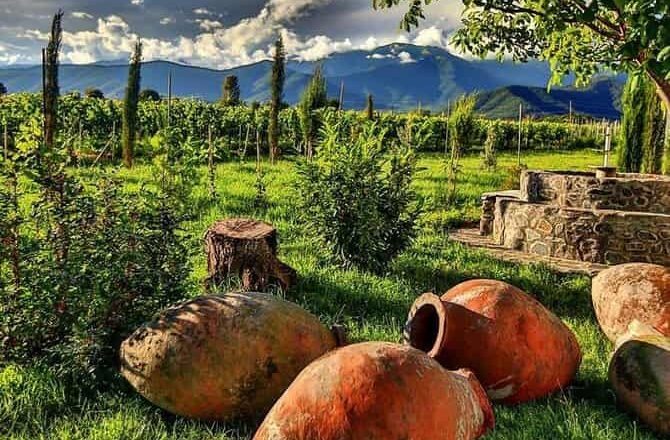Kakheti is the most important wine region in Georgia in quantitative, qualitative, and even historic terms. Almost three-quarters of the country’s wine grapes are grown here, on land that has been used for viticulture for thousands of years.
Kakheti is home to some of the oldest human habitations in the entire Caucasus region, and archaeological findings have suggested that wine has been produced here for several thousand years. The region’s strong relationship with wine and vine was captured in Georgia’s famous hymn ‘Thou Art a Vineyard, written in the 12th Century by King Demetrius I.Vineyards in Kakheti, Georgia.
A historical Georgian province, Kakheti is not an official administrative province in the modern-day. Vinicultural speaking, the area is unofficially divided into several sub-regions and even a number of microregions. This creates a huge variety of microclimates for viticulture with an equally large variety of grape varieties found throughout. The most significant of these centers around the villages of Tsinandali, Telavi, Gurajaani, Kvareli, Sagarejo, and Sighnahi, which dot the banks of the Alazani River as it flows from the Caucasus Mountains to the Mingecevir reservoir in western Azerbaijan.
Kakheti has a transient continental climate with mild to subtropical temperatures as well as arid conditions to ample rainfall for viticulture. Predominately, viticultural areas have an arid climate with rainfall conserved in the winter months. Interestingly, in the particularly humid areas of Shida Kakheti, irrigation is required due to the high level of evapotranspiration. The nutrient-poor soils here are something of a trademark for viticulture as their discovery saw the early Georgian vignerons (as far back as 6000 BC) stumble across near-perfect terroir millennia before the concept of terroir was formalized and given a name.
A particular kind of soil, called ‘cinnamon, is found in Kakheti’s key wine-growing zones. This typically comprises sandy, reddish-colored, calcareous clays. The soil’s color is the result of its high iron content, which also serves to bring a depth of flavor and rustic, earthy notes to the local wines. This type of soil occurs in the drier regions where organic matter decays rapidly and does not accumulate in the topsoil. This motivates vines to dig deep in search of nutriment, forming strong, complex root systems without being deprived of water. Cinnamonic soils are found in various locations around the Black Sea, notably Kakheti and Apkhazeti in Georgia, as well as viticultural areas of Bulgaria.
The principal grape varieties used in Kakheti’s red wines (Saperavi and Cabernet Sauvignon) establish a balance between east and west, traditional and modern, Georgian and French. Their white counterparts are made mostly from Rkatsiteli and Kakhuri Mtsvani grapes. The wine produced using the traditional Kakhetian methods of extended skin contact and no filtration is earning modern-day respect with the resurgence of Orange Wine becoming increasingly popular.




